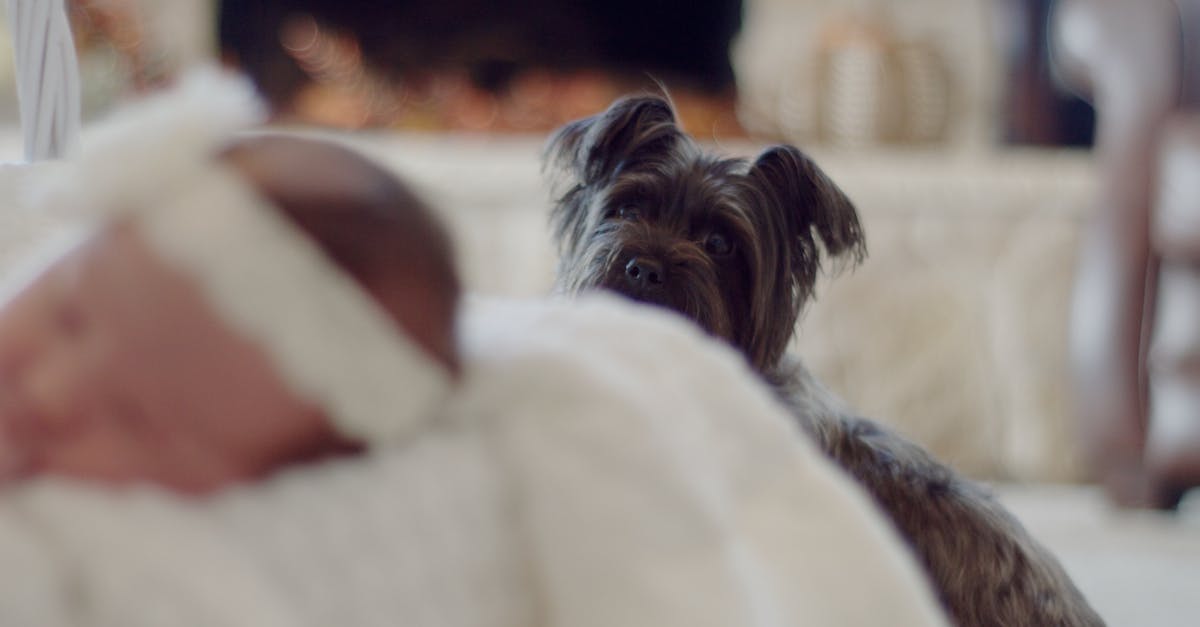Business
How to Introduce a New Puppy to Your Dog: Step-by-Step Guide for Success
Learn how to smoothly introduce a new puppy to your dog with this step-by-step guide. Discover tips for creating a stress-free environment, establishing separate spaces, and using positive reinforcement. Find out the benefits of scent swapping and gain insight into controlled interactions. Patience and consistency are key during this adjustment period.
Published
1 year agoon

Bringing a new puppy into your home is an exciting and joyful experience. However, introducing your new furry friend to your existing dog can be a bit challenging. As a dog lover and experienced pet owner, I understand the importance of a smooth and successful introduction. In this article, I’ll share my top tips and strategies on how to introduce a new puppy to your dog, ensuring a harmonious and happy transition for everyone involved.
First impressions are crucial, and that holds true for our furry friends as well. I’ll guide you through the initial meeting between your dog and the new puppy, providing step-by-step instructions on how to create a positive and stress-free environment. We’ll discuss the importance of proper supervision and how to manage any initial signs of tension or aggression. By following these guidelines, you’ll set the stage for a strong and positive relationship between your dog and the new addition to your family.
Additionally, we’ll explore the importance of gradual introductions and how to establish a routine that fosters bonding and cooperation. From scent swapping to controlled interactions, I’ll share proven techniques that will help your dog and puppy build trust and familiarity. By the end of this article, you’ll be equipped with the knowledge and tools to successfully introduce a new puppy to your dog, ensuring a lifetime of friendship and companionship.
The Importance of Introducing Your Puppy to Your Dog
Introducing a new puppy to your dog is an exciting time for everyone involved. It’s a chance to expand your furry family and bring a new source of joy and companionship into your home. However, it’s important to approach the introduction with care and consideration to ensure a smooth transition for both your dog and the new addition.
Why is introducing your puppy to your dog so important?
- Establishing pack hierarchy: Dogs are pack animals by nature, and they are instinctively inclined to establish a hierarchy within their group. By introducing the puppy to your dog, you’re allowing them to establish their respective roles within the family unit. This process helps to prevent any potential conflict or aggression down the line.
- Promoting socialization: Socializing a puppy is crucial for their emotional development and overall well-being. By exposing them to new experiences and interactions with other dogs, you’re helping them develop the necessary social skills to navigate the world around them. Introducing your puppy to your dog provides a valuable opportunity for socialization in a safe and controlled environment.
- Building a bond: Building a bond between your dog and the new puppy is essential for fostering a harmonious relationship within your household. Through positive interactions and shared experiences, your dog and puppy will develop a sense of familiarity and connection that will last a lifetime. This bond will make it easier for them to coexist and create a strong foundation for their future interactions.
How can you ensure a successful introduction?
- Prepare the environment: Before the initial meeting, ensure that the environment is calm and stress-free. Remove any toys or resources that may lead to possessiveness or tension. Create separate spaces for your dog and the puppy initially, gradually allowing supervised interaction over time.
- Supervise and manage interactions: During the introduction, closely supervise the interactions between your dog and the puppy. Keep them on a leash or use baby gates to maintain control and prevent any potential altercations. Reward positive behavior and redirect any signs of tension or aggression.
- Take it slow and gradual: Patience is key during the introduction process. Start with short and controlled periods of interaction, gradually increasing the duration over time. Allow both your dog and the puppy to acclimate to each other’s presence, ensuring that they feel comfortable and secure.
Step-by-Step Guide for the Initial Meeting
Introducing a new puppy to your dog can be an exciting and sometimes challenging process. To ensure a successful initial meeting, it’s important to take things slowly and follow a step-by-step approach. Here’s a guide to help you navigate the introduction process:
1. Choose the right time and location
Select a neutral location for the initial meeting, such as a park or a friend’s backyard. This helps to prevent territorial behavior from either dog. Make sure both dogs are well-rested and have had a chance to relieve themselves before the meeting.
2. Keep both dogs on a leash
For safety purposes, it’s crucial to have both dogs on a leash during the first meeting. This allows you to have control over the situation and step in if needed. Keep the leashes loose to allow for natural movement, but be ready to gently guide the dogs away from each other if necessary.
3. Start with parallel walks
Before allowing the dogs to interact directly, begin with parallel walks. Walk your dog and the new puppy side by side, keeping a safe distance between them. This allows the dogs to become familiar with each other’s presence without feeling overwhelmed.
4. Observe body language
Pay close attention to the body language of both dogs during the initial meeting. Watch for signs of aggression, fear, or discomfort, such as raised hackles, growling, or excessive barking. If any signs of tension arise, calmly separate the dogs and seek professional guidance before proceeding further.
5. Controlled interactions
Once the dogs are comfortable walking side by side, you can move on to controlled interactions. Allow brief periods of sniffing and gentle greetings, but be ready to intervene if things escalate. Gradually increase the duration of these interactions as the dogs become more comfortable with each other.
6. Monitor and manage play
If both dogs are showing positive body language and are comfortable with each other, you can consider allowing them to play together. Monitor their play closely and interrupt any rough or inappropriate behavior. It’s important to create a positive and enjoyable environment for both dogs, ensuring that playtime remains safe and fun.
Remember, introducing a new puppy to your dog requires patience and understanding. Each dog is unique, and the introduction process may take time. With careful management and a step-by-step approach, you can help your dogs establish a positive relationship and lay the foundation for a harmonious coexistence.
Creating a Positive and Stress-Free Environment
When introducing a new puppy to your dog, it’s essential to create a positive and stress-free environment for both animals. This will help them feel more comfortable and open to forming a bond with each other. Here are a few key steps to take in order to create the best possible environment for their introduction:
1. Choose a Neutral Location: Selecting a neutral location for the initial meeting is crucial. This can be a park, a friend’s backyard, or any other area where neither dog has established territory. By choosing a neutral location, you can reduce territorial behavior and make the introduction go more smoothly.
2. Remove Potential Triggers: Before bringing the new puppy into the environment, it’s important to remove any potential triggers that might cause anxiety or aggression in your existing dog. This could include toys, food bowls, or other items that your dog is possessive of. By removing these triggers, you can prevent any conflicts from arising during the introduction.
3. Create Separate Spaces: As you introduce the new puppy to your dog, it’s important to create separate spaces for each animal. This can be done by using baby gates or crates to give each dog their own area. Having separate spaces allows them to get used to each other’s presence without feeling overwhelmed or threatened.
4. Use Positive Reinforcement: During the introduction process, it’s essential to use positive reinforcement techniques to reward good behavior. This can include giving treats, praise, or even a favorite toy when both dogs display calm and friendly behavior towards each other. Positive reinforcement helps create a positive association between the dogs and makes them more likely to form a positive bond.
5. Supervise Interaction: While it’s important to allow controlled interactions between the dogs, it’s equally important to supervise these interactions closely. Watch their body language and behavior to ensure that things are going well. If either dog shows signs of stress or aggression, separate them and try again later. It’s crucial not to leave them unattended until you are confident in their ability to get along.
The Role of Proper Supervision
Introducing a new puppy to your dog can be an exciting but delicate process. One of the most important aspects of a successful introduction is proper supervision. As the owner, it is crucial that you closely observe the interactions between your dogs and intervene when necessary. This will help ensure a smooth transition and prevent any potential conflicts or misunderstandings.
Here are a few reasons why proper supervision is key when introducing a new puppy to your dog:
- Safety: When bringing a new puppy into your home, it’s essential to prioritize the safety of both animals. By actively supervising their interactions, you can prevent any aggressive behavior or potential harm. This includes keeping a close eye on their body language, such as raised hackles, growling, or stiff posture, which could indicate stress or aggression.
- Establishing Boundaries: Supervision allows you to establish and reinforce boundaries between your dog and the new puppy. It’s important to teach your puppy what is acceptable behavior and what is not. By stepping in when necessary, you can redirect their attention and prevent any negative behaviors from escalating.
- Building Positive Associations: The introduction process should be a positive experience for both dogs. Through proper supervision, you can encourage positive associations and reinforce good behavior. This may include rewarding calm and friendly interactions with treats or praise. It’s important to remember that patience and consistency are key during this phase.
- Preventing Overwhelm: A new puppy can be overwhelming for an existing dog, particularly if they are not used to sharing their space. By supervising their interactions, you can prevent your dog from becoming overwhelmed and provide them with the opportunity to adjust at their own pace. This may involve giving each dog separate spaces and gradually increasing their time together as they become more comfortable.
Proper supervision plays a vital role in introducing a new puppy to your dog. By closely monitoring their interactions, you can ensure their safety, establish boundaries, build positive associations, and prevent any overwhelming situations. Remember to always prioritize the well-being of both animals and intervene when necessary.
Managing Tension and Aggression
Introducing a new puppy to your dog can sometimes result in tension or aggression between the two animals. It’s important to address these issues promptly and effectively to ensure the safety and well-being of both pets. Here are some strategies for managing tension and aggression during the introduction process:
1. Provide Separate Spaces: One of the most effective ways to manage tension is by providing each animal with their own separate space. This can be achieved by using baby gates or crates to create designated areas for each pet. Having their own space allows them to feel safe and secure, reducing the likelihood of aggression.
2. Use Positive Reinforcement: Positive reinforcement is a powerful tool for shaping desired behaviors and creating positive associations. Rewarding both animals for calm and respectful behavior can help reduce tension and aggression. Offer treats or praise when they display appropriate interactions and gradually increase the time they spend together in a controlled and supervised environment.
3. Supervise Interactions: Proper supervision is crucial when introducing a new puppy to your dog. Always be present during their interactions and closely observe their body language and behavior. Look out for signs of stress or aggression, such as growling, snarling, or stiff body posture. If you notice any signs of tension, immediately separate the animals and give them some time apart before trying again.
4. Seek Professional Help if Needed: If the tension or aggression persists despite your best efforts, it may be beneficial to seek the help of a professional dog trainer or behaviorist. They can provide expert guidance and tailor a training plan to address the specific issues between your pets. Professional intervention can make a significant difference in managing tension and ultimately achieving harmony between your dog and new puppy.
Remember, managing tension and aggression takes time and patience. Rushing the introduction process or pushing the animals too quickly can exacerbate the issues. Take it slow, monitor their interactions closely, and prioritize their safety and well-being. With consistent effort and the right strategies, you can create a positive and harmonious relationship between your dog and new puppy.
Gradual Introductions and Establishing a Routine
Introducing a new puppy to your existing dog can be an exciting and rewarding experience. However, it’s important to approach the introduction process with caution and care to ensure the well-being of both animals. Gradual introductions and establishing a routine are key factors in creating a positive and harmonious environment for your furry friends. Here are some steps to follow:
- Start with a Neutral Location: When you bring your new puppy home, choose a neutral location for the initial introductions. This could be a park or a friend’s backyard. By eliminating any territorial feelings, you can help reduce tension and potential conflicts between the two dogs.
- Remove Potential Triggers: Before the introduction, make sure to remove any toys, food bowls, or other items that may trigger possessive behavior in your existing dog. This will help minimize any potential for resource guarding and create a more relaxed atmosphere for both dogs.
- Create Separate Spaces: To ensure a smooth transition, it’s essential to establish separate spaces for your new puppy and existing dog. This will give them each a safe and comfortable place to retreat to when they need some alone time. Use baby gates or create separate rooms for them, with their beds, toys, and water bowls.
- Establish a Routine: Dogs thrive on routine, so it’s crucial to establish a consistent schedule for feeding, exercise, and bathroom breaks. This will help your new puppy and existing dog feel more comfortable and secure in their new home. Stick to the same times for meals, walks, and playtime, and gradually introduce new activities over time.
- Use Positive Reinforcement: During the introduction process, reinforce positive behaviors with treats, praise, and affection. Reward both dogs for calm and friendly interactions, and redirect any signs of tension or aggression. This will help them associate good behavior with positive outcomes and create a positive association with each other.
Remember, the introduction process should be gradual and closely supervised. If tensions arise, separate the dogs and try again later. It’s important to be patient and understanding as they adjust to their new dynamic.
Avoid rushing the process and seek the help of a professional dog trainer or behaviorist if needed.
The Power of Scent Swapping
When introducing a new puppy to your dog, one of the most effective techniques is scent swapping. Dogs have a highly developed sense of smell, and they use it to communicate and gather information about their surroundings. By swapping scents between the two animals, you can help them become familiar with one another before they even meet face-to-face.
Here’s how scent swapping works:
- Start by rubbing a cloth or towel on the new puppy. You can do this by gently petting them or wrapping the cloth around your hand and letting the puppy sniff it. The goal is to collect their unique scent on the cloth.
- Take the scented cloth and place it near your existing dog’s den or resting area. This allows them to get accustomed to the new puppy’s scent without any direct contact.
- Repeat the process with your existing dog. Rub a cloth on them, collecting their scent, and place it near the new puppy’s space. This helps the puppy become familiar with the scent of their future companion.
By exchanging scents in this way, you are essentially introducing the dogs to each other through their most important sense—smell. This gradual exposure helps them form positive associations and reduces the chances of fear or aggression when they finally meet in person.
The benefits of scent swapping include:
- Familiarity: By allowing the dogs to become acquainted with each other’s scent, you are facilitating a smoother introduction process. They will already have some level of familiarity with one another, which can help alleviate anxiety and stress.
- Bonding: Scent swapping is an excellent way to promote bonding between the dogs. It allows them to recognize each other’s scent as a positive and comforting presence, making it easier for them to form a positive relationship.
- Reduced territorial behavior: Dogs can be territorial, especially when it comes to their designated spaces. By exchanging scents, you are helping the dogs understand that the scent belongs to their new companion, easing any territorial behaviors.
Remember, patience is key when using scent swapping as an introduction technique. Allow the dogs to have regular exposure to each other’s scents before progressing to the next step in the introduction process. It’s important to supervise their interactions closely and intervene if any signs of aggression or tension arise.
Controlled Interactions for Building Trust and Familiarity
When introducing a new puppy to your dog, it’s important to establish controlled interactions between them. This allows both animals to gradually build trust and familiarity with one another. By taking a careful and measured approach, you can help create a positive and harmonious relationship between your pets. Here are some key strategies for managing controlled interactions:
- Supervised Time Together: Start by allowing short, supervised periods of time where the puppy and dog can be in the same space together. This can be done in a controlled environment, such as a securely fenced backyard or a spacious room in your house.
- Positive Reinforcement: During these interactions, it’s crucial to reinforce positive behavior from both the puppy and the dog. Reward them with treats, praise, and affection for calm and friendly behavior. This helps them associate each other’s presence with positive experiences and encourages a bond to form.
- Gradual Increase in Time: As the puppy and dog become more comfortable with each other’s presence, gradually increase the duration of their supervised interactions. Observe their body language and behavior closely to ensure that they remain relaxed and at ease. If any signs of tension or aggression arise, separate them immediately.
- Structured Activities: Incorporate structured activities to help the puppy and dog interact in a controlled manner. These can include supervised play sessions with appropriate toys, short walks together, or even training exercises that involve both animals. These activities provide positive experiences and promote bonding between them.
- Separate Spaces: Even though your ultimate goal is for the puppy and dog to coexist peacefully, it’s important to provide separate spaces for each of them initially. This allows them to have their own safe haven and reduces the chances of territorial behavior or resource guarding.
Remember, the introduction process requires time, patience, and consistency. Be prepared for setbacks and take things at a pace that suits both your puppy and dog. If tensions persist or escalate, consider seeking guidance from a professional dog trainer or behaviorist. They can provide valuable insights and techniques to ensure a successful introduction and a harmonious relationship between your furry friends.
Conclusion
Introducing a new puppy to your dog can be a smooth and successful process if done correctly. By following the step-by-step guide provided in this article, you can create a positive and stress-free environment for both animals. Remember to choose a neutral location for the initial introduction, remove potential triggers, and establish separate spaces for each dog. It’s important to establish a routine and use positive reinforcement to encourage good behavior.
Gradual introductions and closely supervising interactions between the dogs are key. If tensions arise, don’t hesitate to seek professional help. Patience and understanding are crucial during the adjustment period.
Scent swapping is a powerful technique that can help familiarize the dogs with each other. By swapping scents, you can promote bonding and reduce territorial behavior.
Controlled interactions between the puppy and dog should be supervised, with positive reinforcement and structured activities. Gradually increase their time together and provide separate spaces when needed.
Remember, introducing a new puppy to your dog takes time, patience, and consistency. With the right approach and guidance, you can successfully integrate your new furry family member into your home.
Frequently Asked Questions
Q: What are the key steps for introducing a new puppy to an existing dog?
A: The key steps for introducing a new puppy to an existing dog include choosing a neutral location, removing potential triggers, creating separate spaces, establishing a routine, using positive reinforcement, and gradually introducing them while closely supervising their interactions.
Q: What should I do if tensions arise between the new puppy and existing dog?
A: If tensions arise, seek professional help for guidance. It’s important to remain patient and understanding during the adjustment period. Be consistent with the introduction process and provide a positive and stress-free environment for both dogs.
Q: How does scent swapping help in introducing dogs?
A: Scent swapping helps by creating familiarity and bonding between the dogs. It reduces territorial behavior and eases the introduction process. It involves exchanging items with each dog’s scent, such as bedding or toys, to help them become accustomed to each other’s smells.
Q: How can I facilitate controlled interactions between the puppy and dog?
A: Facilitate controlled interactions by initially providing supervised time together in a neutral location. Use positive reinforcement to reward good behavior and gradually increase the time spent together. Engage them in structured activities and ensure they have separate spaces for downtime. Consistency, patience, and time are essential during this process.
Q: What is the importance of seeking professional guidance?
A: Seeking professional guidance is crucial if tensions persist or escalate between the dogs. Experts can provide personalized advice and interventions to address specific issues. They can help ensure the introduction process is successful and promote a harmonious relationship between the puppy and existing dog.
With over a decade of experience in the tech industry, Priya Sharma is a seasoned software engineer and tech blogger. She holds a Bachelor's degree in Computer Science from the Indian Institute of Technology (IIT) and has been a key contributor to cutting-edge projects in artificial intelligence and software development.

You may like
Mobility Scooter


Sideways Market: Navigating the Fluctuating Trends
Understanding Market Volatility Market volatility refers to the degree of variability in the price of a financial instrument within a...


Enhance Your iPhone with Adorable Cute Wallpapers
Looking to jazz up your iPhone screen with some cuteness? Discover the impact of adorable wallpapers on your device's look...


Glow Berry Prime: The Science Behind its Skincare Revival
Discover the transformative power of Glow Berry Prime in skincare with its potent blend of 20% Vitamin C, 2% Hyaluronic...


Glov Beauty: Eco-Friendly Products Review | Glov Beauty Reviews
Discover Glov Beauty's eco-friendly products like the Glov On-The-Go set with 500+ uses and the gentle exfoliation offered by the...


Unlocking Drake’s FPS Lyrics: How Gaming Influences His Music
Discover how Drake's lyrics in the first-person shooter-inspired track "War" reflect the influence of FPS games on his music. With...


Defeating a Fire-Breathing Dragon: Strategies for Mage Survival
Prepare yourself for an intense battle as we explore how to face a dragon capable of reaching temperatures over 2000°F....


Exploring Student Life at Glitties Eckerd College
Discover the dynamic student experience at Glitties Eckerd College with a plethora of club options, competitive sports, and community service...


Discover Success Stories with Money6x Real Estate Strategy
Discover the lucrative world of real estate investing with Money6x strategy! Uncover real-life success stories of investors achieving impressive 8-12%...


Get an Inside Look at Julion Alvarez’s 2024 USA Tour
Discover the meticulous planning behind Julion Alvarez's 2024 USA tour! Dive into the world of setlist curation, choreography design, and...


Enhancing Connections through Diversity & Active Listening
Learn how treating peers with empathy and actively listening can enhance relationships and boost innovation. The article emphasizes the significance...